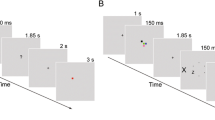Abstract
In two experiments, the effects of taxing selective attention processes on the efficiency of working memory processes were considered in relation to normal aging. In both experiments, the presence of task-irrelevant information disrupted the efficiency of working memory processes, and the effect was generally greater for older than for younger adults. The presence of distracting information increased the frequency of intrusion errors in both younger and older adults and of memory-based errors in older adults. These findings suggest that distraction disrupts both the ability to maintain a coherent stream of goal-directed thought and action in younger and older adults and the encoding and retention of relevant information in older adults.
Similar content being viewed by others

References
Baddeley, A. (1986).Working memory. Oxford: Oxford University Press.
Blanco, M. J., &Alvarez, A. A. (1994). Psychometric intelligence and visual focused attention: Relationships in nonsearch tasks.Intelligence,18, 77–108.
Cohen, J. D., &Servan-Schreiber, D. (1992). Context, cortex, and dopamine: A connectionist approach to behavior and biology in schizophrenia.Psychological Review,99, 45–77.
Conway, A. R. A., Tuholski, S. W., Shisler, R., & Engle, R. W. (1998).The effect of memory load on negative priming: An individual differences investigation. Manuscript submitted for publication.
Cowan, N. (1988). Evolving conceptions of memory storage, selective attention, and their mutual constraints within the human information processing system.Psychological Bulletin,104, 163–191.
Cowan, N. (1995).Attention and memory: An integrated framework. New York: Oxford University Press.
Craik, F. I. M., &Byrd, M. (1982). Aging and cognitive deficits: The role of attentional resources. In F. I. M. Craik & S. Trehub (Eds.),Aging and cognitive processes (pp. 191–211). New York: Plenum.
Duncan, J., Emslie, H., Williams, P., Johnson, R., &Freer, C. (1996). Intelligence and the frontal lobe: The organization of goaldirected behavior.Cognitive Psychology,30, 257–303.
Engle, R. W., Conway, A. R. A., Tuholski, S. W., &Shisler, R. J. (1995). A resource account of inhibition.Psychological Science,6, 253–262.
Gold, D., Andres, D., Arbuckle, T., &Schwartzman, A. (1988). Measurement and correlates of verbosity in elderly people.Journal of Gerontology: Psychological Sciences,43, P27-P33.
Hamm, V. P., &Hasher, L. (1992). Age and the availability of inferences.Psychology & Aging,7, 56–64.
Hartman, M., &Hasher, L. (1991). Aging and suppression: Memory for previously relevant information.Psychology & Aging,6, 587–594.
Hasher, L., Stoltzfus, E. R., Zacks, R. T., &Rypma, B. A. (1991). Age and inhibition.Journal of Experimental Psychology: Learning, Memory, & Cognition,17, 163–169.
Hasher, L., &Zacks, R. T. (1988). Working memory, comprehension, and aging: A review and a new view.Psychology of Learning & Motivation,22, 122–149.
Heathcote, A. (1995).RTSYS Version 1 [Computer software]. Callaghan, NSW, Australia: Author.
Kramer, A. F., Humphrey, D. G., Larish, J. F., Logan, G. D., &Strayer, D. L. (1994). Aging and inhibition: Beyond a unitary view of inhibitory processing in attention.Psychology & Aging,9, 491–512.
McDowd, J. M., &Filion, D. L. (1992). Aging, selective attention, and inhibitory processes: A psychophysiological approach.Psychology & Aging,7, 65–71.
Roberts, R. J., Hager, L. D., &Heron, C. (1994). Prefrontal cognitive processes: Working memory and inhibition in the antisaccade task.Journal of Experimental Psychology: General,123, 374–393.
Rouleau, N., &Belleville, S. (1996). Irrelevant speech effect in aging: An assessment of inhibitory processes in working memory.Journal of Gerontology: Psychological Sciences,51B, P356-P363.
Salthouse, T. A. (1992). Influence of processing speed on adult age differences in working memory.Acta Psychologica,79, 155–170.
Salthouse, T. A. (1996). The processing-speed theory of adult age differences in cognition.Psychological Review,103, 403–428.
Salthouse, T. A., Babcock, R. L., &Shaw, R. J. (1991). Effects of adult age on structural and operational capacities in working memory.Psychology & Aging,6, 118–127.
Shallice, T. (1982). Specific impairments of planning.Philosophical Transactions of the Royal Society of London: Series B,298, 199–209.
Spieler, D. H., Balota, D. A., &Faust, M. E. (1996). Stroop performance in healthy younger and older adults and in individuals with dementia of the Alzheimers type.Journal of Experimental Psychology: Human Perception & Performance,22, 461–479.
Tipper, S. P. (1991). Less attentional selectivity as a result of declining inhibition in older adults.Bulletin of the Psychonomic Society,29, 45–47.
West, R. (1999). Age differences in lapses of intention in the Stroop task.Journal of Gerontology: Psychological Sciences,54B, P34-P43.
West, R., &Baylis, G. C. (1998). Effects of increased response dominance and contextual disintegration on the Stroop interference effect in older adults.Psychology & Aging,13, 206–217.
Author information
Authors and Affiliations
Corresponding author
Additional information
The research reported in this article was supported by a postdoctoral fellowship to the author, funded by Grant RO1 AG13845-01 from the National Institute of Aging, awarded to L. L. Jacoby and F. I. M. Craik.
Rights and permissions
About this article
Cite this article
West, R. Visual distraction, working memory, and aging. Mem Cogn 27, 1064–1072 (1999). https://doi.org/10.3758/BF03201235
Received:
Accepted:
Published:
Issue Date:
DOI: https://doi.org/10.3758/BF03201235



